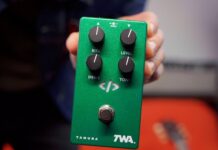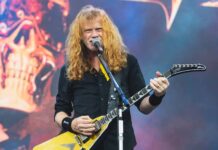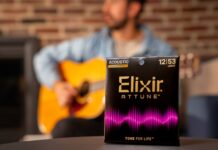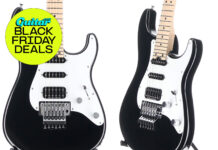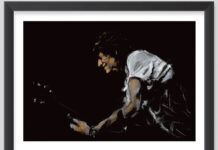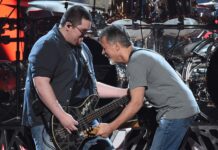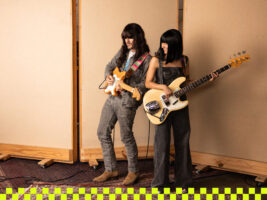
“I’m not a guitar player – I play THAT guitar” how Khruangbin recreated their unique voice on their first signature instruments
There has always been an element of belief behind Khruangbin’s music, but it’s perhaps become more important than ever in the here and now. The Texan trio emerged from the pandemic as an arena-sized draw thanks to their ready-made salve of a record Mordechai, but their approach to writing and performance hasn’t been beaten into a new shape by the demands of relative ubiquity. Instead, it remains grounded in the simpatico melodic sensibilities of guitarist Mark Speer and bassist Laura Lee, with winding, sun-bleached hooks popping and whirring over drummer Donald ‘DJ’ Johnson’s supine grooves.
READ MORE: Judy Schaefer of PRS: “Music is all about community building. If we do better, everybody else does better”
So while their audiences sometimes spiral into the tens of thousands these days, each person in the room is still being challenged to follow the music along unfamiliar paths, where dubby bass meets lead lines that snake in and out of ringing harmonies. “All you can see are maybe the first 100 people and you’ve got to trust that it’s resonating,” Lee observes. “And, actually, most of the time the trust comes from us leaning into playing with each other. If we do it, then they’re gonna feel it. It’s deep.”
Good Hangs
Appropriately, Khruangbin’s recent album A La Sala was chiefly an exercise in reconnecting with the band’s low-stakes origin as friends hanging out in a barn in rural Texas, digging up sounds and jamming them out. Cutting back against the Tom Tom Club-gone-desert-rock grain of Mordechai, it returned them to a vocal-agnostic wash of melodies, counter melodies and snappy rhythms, propelled by worn-in chemistry and a magpie’s eye for sonic touchstones.
It was a work by musicians who understand what they’re about, patient and certain. “I remember when we first started making music it seemed very subversive that we were instrumental,” Lee says. “It might have been challenging but [listeners] reward themselves with that breath.”
Lee and Speer have taken a similarly deliberate, unfussy approach to their first signature instruments. In collaboration with Fender the duo are about to put out a Jazz bass and Strat that are equal parts functional and aspirational. Speer’s model is fashioned after the only guitar he ever plays: an early 2000s reissue done up with single-coil-sized humbuckers in the neck and bridge that has been around the block with him a couple of hundred times over the past 20 years and change.
Mark Speer and his signature Fender Stratocaster. Image: Fender
“If someone handed me their guitar I’d be like, ‘Wow, what a nice instrument,’ but I won’t sound very good on it,” he says. “I’m used to mine. I’m not a guitar player – I play that guitar. I’ve been using that one thing for the whole time. I know exactly where certain notes are going to sing more than others. Or if I play here versus here, I can really control the timbre of where things are happening and why – the volume knob, things that I do against the gain structure, it’s all part of the voice. Really, it’s my voice, right?”
Tone-hounds will be pleased to know that Speer’s signature is wedded to this reality. Reflecting his own setup, it’s home to DiMarzio Pro TrackTMs either side of a 70s Strat pickup in the middle, with jumbo frets, a synchronised tremolo and Graph Tech saddles and string trees. “A lot of those adjustments were made from a pragmatic standpoint,” he says. “Literally so I could work more – the Graph Tech saddles were there because I just don’t want strings to break that often. When you’re a struggling working musician, buying strings all the time is not something you like doing.”
“The guitar is very similar to my main one and that was the whole point,” he continues. “It also feels the same way. The bit that routes the body out – it was a discontinued way they used to do it. They were very kind to bring that back. I think they just went and found the bit and put it back on the router to make it.”
Laura Lee and her signature Fender Jazz Bass. Image: Fender
Math Problem
Lee’s bass story runs back to the late ‘00s and her tenure as a maths teacher, a job she ditched to head out on tour with Speer and shoegaze noisemaker Yppah only a few months after picking one up for the first time. Soon after, they decided to form Khruangbin, a band that’s always viewed her instrument as a melodic voice as well as something that’ll rattle around in your chest. Her Jazz bass is a dream fulfilled in many ways – for years she’s been using a budget Fender-alike from SX. “I played a knockoff Fender because I couldn’t afford a real Fender when we started,” she says. “Now my signature model will be a real Fender. There’s something pretty glorious about that.”
A marriage of vintage white and chrome that culminates in an uber-retro chunky bridge cover, Lee’s guitar is kitted out with DiMarzio Ultra JazzTMs, plus concentric volume and tone knobs for each pickup, a custom U-shape neck and a rosewood fingerboard. “I had just started playing bass when I came to Mark and DJ saying, ‘Let’s start a band,’” Lee says. “Mark helped me set up my bass to be really good for a young player.”
“The strings don’t buzz because of the humbuckers he encouraged me to put in,” she adds. “Why sit and be so frustrated with your strings ringing out as a young player? Focus on actually learning how to play. I liked the sustain that it was giving me, and I liked the non-buzziness of my sound. That is up to you now. But, for me, I got the tone that I wanted as a young player. I hope that my bass can be suited to a young player, or can make a more expert player feel young in spirit.”
Trust Fall
Much like trust, that feeling of youthfulness is an important part of Khruangbin’s make-up. It’s remarkable that, even as Lee points out how little bass she’d played before starting the band, their sound appeared dialled in from minute one. If there’s a reason that A La Sala’s retrospective approach felt a little like coming home then it’s because most of its constituent parts were there on the band’s 2015 debut The Universe Smiles Upon You. There are some major non-musical factors to consider in that – shared histories playing in church bands, for example, or the cultural kaleidoscope of Houston – but fundamentally it’s because they were willing to work things out in a room together, pushing for something honest rather than striving for something confected.
“I’m thinking about the translation of these things live,” Lee reflects. “There are these songs where we’re playing different things and then we merge to play the same melody. It’s like we’re singing together. I feel like those might be the most powerful moments from an audience perspective. There’s something really simple about it. We’re three instruments and two of them have the ability to make melodies. Leaning into that feels like who we are. At the start of the band, Mark really let me lead. I think he found my beginner’s mind very beautiful – it would come up with things that he could never come up with. You can never go backwards and approach an instrument like a new person again. I think it allowed him to be a beginner, in a way. He had to play around what I created, and that was an exciting prospect for him.”
“It might be frustrating, like, ‘What? This doesn’t make any sense!’” Speer chimes in. “But, I mean, you can get bogged down in a theory and why this makes sense, or why this is right or wrong. But, who cares? Make music that makes you feel something – that’s really the whole point. If it’s wrong, but I feel great listening to it, well, then it’s very right, isn’t it?”
The fourth aspect of Khruangbin’s sound that needs considering at this stage is nothingness – the gaps that they leave, sometimes heavy with possibility and other times only as red herrings. They have embraced the classic power-trio dilemma and opted not to fill things out in a manner that would require a few extra pairs of hands on stage, allowing their songs a sense of possibility even within the constraints of their make-up. When this aspect of their sound is put to them, Lee and Speer respond in a manner that’s both philosophical and practical, which seems fitting. “We’re so inundated with visual and sound pollution,” Lee observes. “People rarely are not listening to anything. You’re in an Uber or at a train station, you’re walking with your headphones on. It’s almost rare that it’s quiet.”
“Initially, the pedals I was bringing on board were very simple: a wah, distortion, a reverb,” Speer adds. “The echoes and phasers and choruses came in much later. That [early] thing was us in the barn playing with relatively simple signal chains. It’s like, ‘Well, what can we get rid of?’ I need to be able to play the melody, so if I’m getting rid of the chords, now you’ve got bottom and you have top, and there’s nothing in the middle, which is nice. Especially in this day and age, there are layers upon layers. There’s no space in much of the music I end up hearing. I think with this there’s really not a whole lot in the middle, but there are sounds from the barn or birds or wind or trees. It gives the listener a place to live and to think. There’s space for mystery in there.”
Find out more about the Khruangbin signature instruments at fender.com
The post “I’m not a guitar player – I play THAT guitar” how Khruangbin recreated their unique voice on their first signature instruments appeared first on Guitar.com | All Things Guitar.
Source: www.guitar-bass.net


